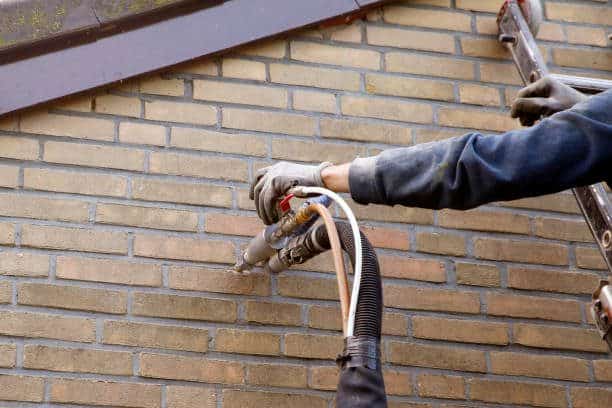BBC News have recently reported on a tenant’s claim that cavity wall insulation has led to nearly a decade of damp conditions in his flat.
The tenant, Blaan Paterson, who lives in East Kilbride, Scotland, had the insulation installed after it was given the go-ahead by the council as part of a Scottish government Universal Home Insulation Scheme (UHIS) around 12 years ago.
He said that shortly after it was installed, it was not long afterwards that the black mould started appearing everywhere in the flat.
Initial investigations by the Cavity Insulation Guarantee Agency (CIGA) – an industry body that offers 25-year warranties on the work – recommended insulation be removed in 2016.
However, even after that work was completed, the mould continued to spread.
UHIS was launched by the Scottish government in 2011. Millions of pounds were spent by local authorities “retrofitting” older homes with cavity wall insulation.
It is understood that in almost all cases, cavity wall insulation had been installed under the government scheme. The majority of residents who spoke to the BBC said their problems started after insulation was installed in 2011.
Although, a 2015 inspection carried out by South Lanarkshire Council at one of the properties blamed condensation as the root cause.
The inspection recommended “dehumidifiers installed throughout the property for a period of time” but the damp conditions have continued for a further eight years.
As mentioned on our cavity wall insulation page, homeowners affected by issues with damp should consider failed or compromised insulation as a possible cause, but just because a property has cavity wall insulation, it doesn’t always mean it is the insulation causing the problem.
When cavity wall insulation is installed into a property that is located or built in a way that means it should not have the cavities filled, or if the work is undertaken incorrectly, the first and most obvious sign of a problem is almost always internal dampness.
Most homeowners will be blissfully unaware if cavity wall insulation has not been installed correctly. They will not know if it is over-packed, under filled, where it has slumped, where areas have been missed, vents have been blocked or obstructions missed.
We have also seen a growing number of properties where no defects exist with the building or the new insulation, but, owners are reporting new problems with damp. In these instances, it has been found that the insulation has successfully stopped both warm air and moisture escape. Without reintroducing air exchange through controlled ventilation, the wet air has nowhere to go. Subsequently, the humidity levels rise and mould growth is almost inevitable.
Below is a list of common problems, where a property is unsuitable and where defects can occur as a result of poor installation:
- Properties exposed to wind driven rain, especially west coastally areas
- Porous brickwork or mortar
- Defective and cracked external rendering
- Defective rainwater goods (guttering, downspouts, hoppers etc.)
- Debris/blockages in cavities
- Cold bridging caused by missing pockets of insulation
- Condensation and mould growth
- Narrow cavities
- Blocked sub-floor vents (causing fungal decay to timbers)
Providing the property is suitable, cavity wall insulation can provide numerous benefits;
Benefits of cavity wall insulation
- 6 million homes in Britain have now had cavity wall insulation installed, and it’s easy to see why – it’s the smart way to save money.
- The Government regards cavity wall insulation as one of the most effective energy savings measures that most people can carry out on their homes and, apart from saving money, it’s a major contributor to reducing emissions of carbon dioxide, the main greenhouse gas.
- What’s more, millions of homeowners will tell you that insulation is quick, simple and mess free to install, and cavity wall insulation is a safe reliable system that has been used for many years and has a proven track record. In the unlikely event of a problem occurring, the CIGA 25 year Guarantee ensures that access to specialist technical help and assistance is available to provide complete peace of mind.
- External walls account for 35% of heat loss from the average house, and studies suggest that every square metre of cavity wall insulation will save more than a tonne of carbon dioxide over the average life of the building. For a semi-detached house with an external wall area of 80m2, this equates to savings of 80 tonnes or more.
- With an uninsulated cavity, heat can easily escape, meaning it requires more fuel to maintain a comfortable temperature.
- The insulation present in a filled cavity reduces this heat loss, making the house warmer or reducing the amount of fuel required to maintain a comfortable temperature.
- Around 5 million homes still have empty cavities that could have CWI installed, allowing the occupants to enjoy a warmer and cheaper to heat house.
Cavity wall insulation systems
Cavity wall insulation is a simple process by which insulation is injected into this cavity through a carefully designed pattern of holes. The insulation system is designed so that any water that does enter the cavity can drain away, whilst the insulation reduces the heat loss through the wall.
There are a number of different products, or systems, each of which must pass stringent technical requirements laid down by the British Board of Agreement or alternative independent approvals body. All systems are “fit and forget” and require no servicing, maintenance or adjustment.
There are three main systems in common use, and all are suitable for the purpose and (except for UF Foam) can be used in all areas of the UK.
Mineral Wool
Mineral Wool insulation is a cotton wool like material produced from either rock wool or glass wool, and is used in the majority of installations.
Polystyrene Bead
Bead is made up of small expanded polystyrene beads normally injected with a binder.
UF Foam
Urea Formaldehyde cavity wall insulation was introduced into the UK in the late 1960’s and involves the injection of a water based chemicals system that produces an insulating foam in the cavity.
Misdiagnosis and inadequate inspections by inexperienced inspectors are becoming more common. So, what is the answer? Professional expert advice is the key. Anyone carrying out surveys and site inspections MUST be suitably trained and have knowledge and experience with retrofit insulation. RTC are fully qualified damp experts, who are not only able to accurately diagnose the cause of any dampness present, but have vast experience in building design and building defects.
We have also attended specific training courses with regards to retrofit insulation and we are members of the property care industries governing body, The Property Care Association (PCA). We are also recognised by CIGA, and have provided various specifications for remedial works when the insulation has been compromised.
A final thought!
The whole reason for the initial drive by the government (Green Deal), was to reduce carbon emissions cost effectively by improving the energy efficiency of British properties, including homes and businesses.
Over half of the UK’s 26 million homes were insufficiently insulated; The Green Deal was set out to tackle this problem. The initiative was to also help support families in fuel poverty who struggle with the cost of their energy bills.
It is, therefore, imperative that the families who occupy these properties are not left in a worse position than they were before and that they receive the correct advice and support in moving forward.
If problems with cavity wall insulation are suspected, RTC can be trusted to provide you with the best advice possible.

